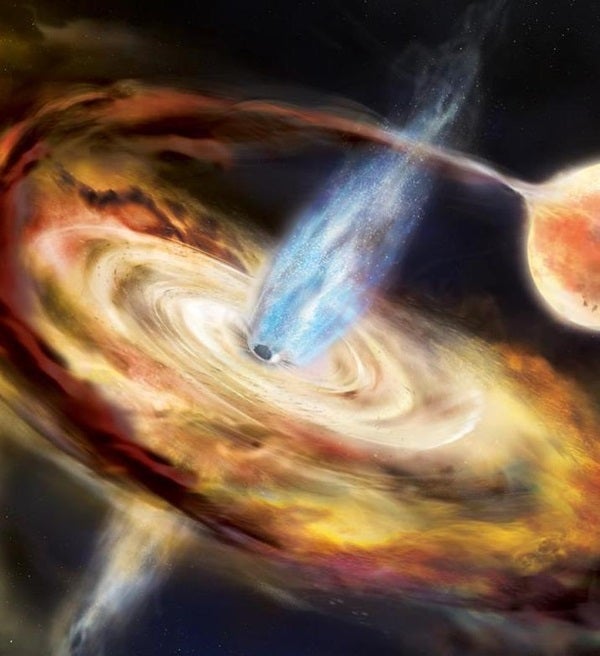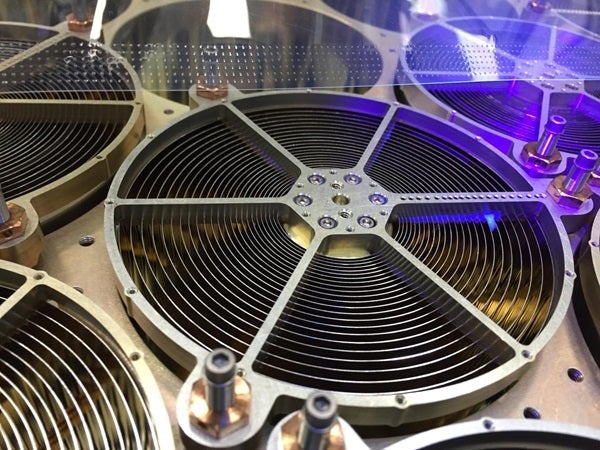That work, published January 9 in Nature, was led by Erin Kara of the University of Maryland and NASA’s Goddard Space Flight Center. Kara also presented the results at a press conference the same day at the 233rd meeting of the American Astronomical Society in Seattle. Using NASA’s Neutron star Interior Composition Explorer (NICER) aboard the International Space Station (ISS), the team watched the stellar-mass black hole (designated MAXI J1820+070, or J1820 for short), which flared to life March 11, every day for months. In that time, they used light echoes, which occur when light from near the black hole is absorbed by the accretion disk farther out and then emitted again in a sort of “echo,” to map out the region close to the black hole and watch how that it changed over time.
“Similar to how bats use echolocation to map out a dark cave that they can’t see, we are using these light echoes to put constraints on what it must look like around this black hole that we cannot resolve spatially with our telescopes,” Kara explained in the press conference.
Black hole geometry
While many black holes are simply sitting calmly in space without nearby material to consume, some are in binary systems where one star has become a black hole, while the companion is at an earlier stage in its life. This is the case for J1820 — the black hole is pulling material off a star, which forms a swirling disk of material that heats up as it falls inward toward the event horizon and disappears. The accretion disk is relatively flat and thin, as its name implies, shining at a temperature of about 18 million degrees Fahrenheit (10 million degrees Celsius). Closer to the black hole lies a spherical “corona” of even hotter electrons, protons, and positrons at almost 2 billion F (1 billion C).
Making a map
During an outburst, the hot corona shines in all directions. Some of that light hits the accretion disk, which absorbs it, heats up, and then emits light of its own. The time it takes for this to happen is the time it takes light to travel (at the speed of light) from the corona to different parts of the accretion disk. Any delay in the echoes between light from the corona and light from the accretion disk tells astronomers how far out in the disk the echoes came from. The timing differences allow researchers to then piece together a picture of what the accretion disk looks like.
This image shows the black hole, accretion disk (orange), and corona (blue). As light from the corona hits the accretion disk, it is absorbed and later emitted as echoes that allow astronomers to map where in the disk the light came from.
NASA’s Goddard Space Flight Center
Closing in
But something else was happening. “As we watched the system over several weeks, we saw that the light echoes got closer and closer together. That was indicating that something in the system was getting smaller – so either the accretion disk coming inwards, or the corona shrinking,” Kara said.
How could they differentiate one from the other? Light echoes from parts of the accretion disk closer to the black hole are redder, because the light is stretched out as it tries to escape the black hole’s immense gravity. This is called gravitational redshifting. Looking at the maximum stretching that occurred told the team how close the accretion disk got to the black hole, as well as whether that distance changed over time.
“We noticed that the most gravitationally redshifted emission – the emission coming from the innermost regions – the amount of that emission did not change at all. So that suggested to us that the disk itself is close to the central black hole and does not evolve over time. But because the light echoes got shorter and shorter, closer and closer together, that must mean that the corona was shrinking,” she said.
Her team estimated that over several weeks, “the corona shrinks from something like 100 miles [160 kilometers] to only 10 [16 km],” Kara said.
“This is the first time that we’ve seen this kind of evidence that it’s the corona shrinking during this particular phase of outburst evolution,” study co-author Jack Steiner at the Massachusetts Institute of Technology’s Kavli Institute for Astrophysics and Space Research said in a press release. “The corona is still pretty mysterious, and we still have a loose understanding of what it is. But we now have evidence that the thing that’s evolving in the system is the structure of the corona itself.”
The bigger picture
This first-of-its kind observation will not only help astronomers better understand the workings of stellar-mass black holes, which are tens of times the mass of the Sun, but can also be applied to supermassive black holes, which are millions or billions of times the mass of the Sun.
“In stellar-mass black holes [these outbursts] evolve over timescales of several weeks to months. So we can watch this evolution happening in real time and we find now that it’s the corona that’s driving that evolution,” Kara said. But in supermassive black holes, she added, such outbursts occur over billions of years. By scaling up what’s going on around smaller black holes over shorter time periods, she explained, astronomers can learn more about how material falls in and causes changes in the region around supermassive black holes on much larger scales. That will, in turn, allow astronomers to better understand how these behemoths affect their local environment, which in turn affects the evolution of the galaxy around them.
“These stellar-mass black holes are a great analogue for studying the evolution of the corona and the accretion geometry in real time,” she said.











